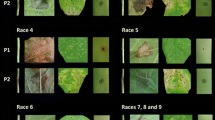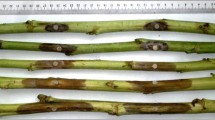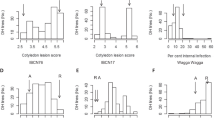Abstract
Verticillium longisporum is a major threat to production of oilseed rape (Brassica napus) in Europe. The aim of the study was to develop new markers and obtain insights into putative mechanisms and pathways involved in the resistance reaction. A genetic approach was used to identify quantitative trait loci (QTL) for V. longisporum resistance and metabolic traits potentially influencing resistance in a B. napus mapping population. Resistance to V. longisporum was mapped in a doubled haploid (DH) population from a cross between the partially resistant winter oilseed rape variety Express 617 and a resistant resynthesized B. napus line, R53. One major resistance QTL contributed by R53 was identified on chromosome C5, while a further, minor QTL contributed by Express 617 was detected on chromosome C1. Markers flanking the QTL also significantly correlated with V. longisporum resistance in four further DH populations derived from crosses between elite oilseed rape cultivars and other resynthesized B. napus lines originating from genetically and geographically diverse brassica A and C genome donors. The tightly-linked markers developed enable the combination of favorable alleles for novel resistance loci from resynthesized B. napus materials with existing resistance loci from commercial breeding lines. HPLC analysis of hypocotyls from infected DH lines revealed that concentrations of a number of phenylpropanoids were correlated with V. longisporum resistance. QTL for some of these phenylpropanoids were also found to co-localize with the QTL for V. longisporum resistance. Genes from the phenylpropanoid pathway are suggested as candidates for V. longisporum resistance.



Similar content being viewed by others
References
Akhtar S, Bhat MA, Wani SA, Bhat KA, Chalkoo S, Mir MR, Wani SA (2010) Marker assisted selection in rice. J Phytol 2:66–81
Allender CJ, King GJ (2010) Origins of the amphiploid species Brassica napus L. investigated by chloroplast and nuclear molecular markers. BMC Plant Biol 10:54
Basunanda P, Spiller TH, Hasan M, Gehringer A, Schondelmaier J, Lühs W, Friedt W, Snowdon RJ (2007) Marker-assisted increase of genetic diversity in a double-low seed quality winter oilseed rape genetic background. Plant Breed 126:581–587
Basunanda P, Radoev M, Ecke W, Friedt H, Becker HC, Snowdon RJ (2010) Comparative mapping of quantitative trait loci involved in heterosis for seedling and yield traits in oilseed rape (Brassica napus L.). Theor Appl Genet 120:271–281
Berg ES, Olaisen B (1994) Hybrid PCR sequencing—sequencing of PCR products using a universal primer. Biotechniques 17:896–901
Broman KW, Wu H, Sen Ś, Churchill G (2003) R/qtl: QTL mapping in experimental crosses. Bioinformatics 19:889–890
Cheng X, Xu J, Xia S, Gu J, Yang Y, Fu J, Qian X, Zhang S, Wu J, Liu K (2009) Development and genetic mapping of microsatellite markers from genome survey sequences in Brassica napus. Theor Appl Genet 118:1121–1131
Dixon RA, Paiva NL (1995) Stress-induced phenylpropanoid metabolism. Plant Cell 7:1085–1097
Dixon RA, Reddy MSS (2003) Biosynthesis of monolignols. Genomic and reverse genetic approaches. Phytochem Rev 2:289–306
Doyle JJ, Doyle JL (1990) Isolation of plant DNA from fresh tissue. Focus 12:13–15
Dunker S, Keunecke H, Steinbach P, von Tiedemann A (2008) Impact of Verticillium longisporum on yield and morphology of winter oilseed rape (Brassica napus) in relation to systemic spread in the plant. J Phytopathol 156:698–707
Eynck C, Koopmann B, Grunewaldt-Stoecker G, Karlovsky P, von Tiedemann A (2007) Differential interactions of Verticillium longisporum and V. dahliae with Brassica napus detected with molecular and histological techniques. Eur J Plant Pathol 118:259–274
Eynck C, Koopmann B, von Tiedemann A (2009a) Identification of Brassica accessions with enhanced resistance to Verticillium longisporum under controlled and field conditions. J Plant Dis Protect 116:63–72
Eynck C, Koopmann B, Karlovsky P, von Tiedemann A (2009b) Internal resistance in winter oilseed rape inhibits systemic spread of the vascular pathogen Verticillium longisporum. Phytopathology 99:802–811
Eynck C, Séguin-Swartz G, Clarke WE, Parkin IAP (2012) Monolignol biosynthesis is associated with resistance to Sclerotinia sclerotiorum in Camelina sativa. Mol Plant Pathol 18:887–899. doi:10.1111/J.1364-3703.2012.00798.X
Fahleson J, Lagercrantz U, Hu Q, Steventon A, Dixelius C (2003) Estimation of genetic variation among Verticillium isolates using AFLP analysis. Eur J Plant Pathol 109:361–371
Fahleson J, Hu Q, Dixelius C (2004) Phylogenetic analysis of Verticillium species based on nuclear and mitochondrial sequences. Arch Microbiol 181:435–442
Floerl S, Druebert C, Majcherczyk A, Karlovsky P, Kües U, Polle A (2008) Defense reactions in the apoplastic proteome of oilseed rape (Brassica napus var. napus) attenuate Verticillium longisporum growth but not disease symptoms. BMC Plant Biol 8:129
Floerl S, Druebert C, Arroud HI, Karlovsky P, Polle A (2010) Disease symptoms and mineral nutrition in Arabidopsis thaliana in response to Verticillium longisporum VL43 infection. J Plant Pathol 92:695–702
Fradin EF, Abd-El-Haliem A, Masini L, van den Berg GCM, Joosten MHAJ, Thomma BPHJ (2011) Interfamily transfer of tomato Ve1 mediates Verticillium resistance in Arabidopsis. Plant Physiol 156:2255–2265
Götze S, Feussner K, Kaever A, Landesfeind M, Drübert C, Herrfurth C, Polle A, Karlovsky P, Meinicke P, Feussner I (2011) Phenylpropanoids in the interaction of Verticillium longisporum and Arabidopsis thaliana. In: Gatz C (ed) From foliar to root-interacting pathogens and symbionts, 16–18 Feb 2011, Georg August University Göttingen: poster presentations: abstract 33. http://wwwuser.gwdg.de/~rootmicr/. Accessed 1 March 2012
Häffner E, Karlovsky P, Diederichsen E (2010) Genetic and environmental control of the Verticillium syndrome in Arabidopsis thaliana. BMC Plant Biol 10:235
Happstadius I, Ljungberg A, Kristiansson B, Dixelius C (2003) Identification of Brassica oleracea germplasm with improved resistance to Verticillium wilt. Plant Breed 122:30–34
Heale JB, Karapapa VK (1999) The Verticillium threat to Canada’s major oilseed crop: Canola. Can J Plant Pathol 21:1–7
Iniguez-Luy LF, Lukens L, Farnham MW, Amasino RM, Osborn TC (2009) Development of public immortal mapping populations, molecular markers and linkage maps for rapid cycling Brassica rapa and B. oleracea. Theor Appl Genet 120:31–43
Joehanes R, Nelson JC (2008) QGene 4.0, an extensible Java QTL-analysis platform. Bioinformatics 24:2788–2789
Johansson A, Goud JKC, Dixelius C (2006a) Plant host range of Verticillium longisporum and miclosclerotia density in Swedish soils. Eur J Plant Pathol 114:139–149
Johansson A, Staal J, Dixelius C (2006b) Early responses in the Arabidopsis-Verticillium longisporum pathosystem are dependent on NDR1, JA- and ET-associated signals via cytosolic NPR1 and RFO1. Mol Plant Microbe Interact 19:958–969
Karapapa VK, Bainbridge BW, Heale JB (1997) Morphological and molecular characterization of Verticillium longisporum comb. nov., pathogenic to oilseed rape. Mycol Res 101:1281–1294
Klosterman SJ, Atallah ZK, Vallad GE, Subbarao KV (2009) Diversity, pathogenicity, and management of Verticillium species. Annu Rev Phytopathol 47:39–62
Lander ES, Botstein DB (1989) Mapping Mendelian factors underlying quantitative traits using RFLP linkage maps. Genetics 121:185–199
Lipsa FD, Snowdon R, Friedt W (2012) Quantitative genetic analysis of condensed tannins in oilseed rape meal. Euphytica 184:195–205
Lowe AJ, Moule C, Trick M, Edwards KJ (2004) Efficient large-scale development of microsatellites for marker and mapping applications in Brassica crop species. Theor Appl Genet 108:1103–1112
Mielke T (2010) Global analysis. All major oilseeds, oils & oilmeals. Supply, demand and prices. Oil World Annual 2. ISTA Mielke GmbH. http://www.oilworld.de
Mittasch J, Mikolajewski S, Breuer F, Strack D, Milkowski C (2010) Genomic microstructure and differential expression of the genes encoding UDP-glucose:sinapate glucosyltransferase (UGT84A9) in oilseed rape (Brassica napus). Theor Appl Genet 120:485–500
Nagaoka T, Doullah MAU, Matsumoto S, Kawasaki S, Ishikawa T, Hori H, Okazaki K (2010) Identification of QTLs that control clubroot resistance in Brassica oleracea and comparative analysis of clubroot resistance genes between B. rapa and B. oleracea. Theor Appl Genet 120:1335–1346
Nicholson RL, Hammerschmidt R (1992) Phenolic compounds and their role in disease resistance. Annu Rev Phytopathol 30:369–389
Padda MS, Picha DH (2007) Methology optimization for quantification of total phenolics and individual phenolic acids in sweetpotato (Ipomoea batatas L.) roots. J Food Sci 72:412–415
Pantelides IS, Fjamos SE, Paplomatas EJ (2010) Ethylen perception via ETR1 is required in Arabidopsis infection by Verticillium dahliae. Mol Plant Pathol 11:191–202
Piquemal J, Cinquin E, Couton F, Rondeau C, Seignoret E, Doucet I, Perret D, Villeger M-J, Vincourt P, Blanchard P (2005) Construction of an oilseed rape (Brassica napus L.) genetic map with SSR markers. Theor Appl Genet 111:1514–1523
Qiu D, Morgan C, Shi J, Long Y, Liu J, Li R, Zhuang X, Wang Y, Tan X, Dietrich E, Weihmann T, Everett C, Vanstraelen S, Beckett P, Fraser F, Trick M, Barnes S, Wilmer J, Schmidt R, Li J, Li D, Meng J, Bancroft I (2006) A comparative linkage map of oilseed rape and its use for QTL analysis of seed oil and erucic acid content. Theor Appl Genet 114:67–80
Radoev M (2007) Genetic Analysis of Heterosis in Rapeseed (B. napus L.) by QTL Mapping. Dissertation, Georg August University Göttingen, Germany. http://webdoc.sub.gwdg.de/diss/2007/radoev. Accessed 1 March 2012
Radoev M, Becker HC, Ecke W (2008) Genetic analysis of heterosis for yield and yield components in rapeseed (Brassica napus L.) by QTL mapping. Genetics 179:1547–1558
Ratzinger A, Riediger N, von Tiedemann A, Karlovsky P (2009) Salicylic acid and salicylic acid glucoside in xylem sap of Brassica napus infected with Verticillium longisporum. J Plant Res 122:571–579
Rygulla W, Seyis F, Lühs W, Eynck C, von Tiedemann A, Friedt W, Snowdon RJ (2007a) Combination of resistance to Verticillium longisporum from zero erucic acid Brassica oleracea and oilseed Brassica rapa genotypes in resynthesised rapeseed (Brassica napus) lines. Plant Breed 126:596–602
Rygulla W, Snowdon RJ, Eynck C, Koopmann B, von Tiedemann A, Lühs W, Friedt W (2007b) Broadening the genetic basis of Verticillium longisporum resistance in Brassica napus by interspecific hybridization. Phytopathology 97:1391–1396
Rygulla W, Snowdon RJ, Friedt W, Happstadius I, Cheung WY, Chen D (2008) Identification of quantitative trait loci for resistance against Verticillium longisporum in oilseed rape (Brassica napus L.). Phytopathology 98:215–221
Stam P (1993) Construction of integrated genetic linkage maps by means of a new computer package: JoinMap. Plant J 3:739–744
Steventon LA, Okori P, Dixelius C (2001) An investigation of the susceptibility of Arabidopsis thaliana to isolates of two species of Verticillium. J Phytopathol 149:395–401
Steventon LA, Fahleson J, Hu Q, Dixelius C (2002) Identification of the causal agent of Verticillium wilt of winter oilseed rape in Sweden, V. longisporum. Mycol Res 106:570–578
Suwabe K, Iketani H, Nunome T, Ohyama A, Hirai M, Fukuoka H (2004) Characteristics of microsatellites in Brassica rapa genome and their potential utilization for comparative genomics in Cruciferae. Breed Sci 54:85–90
U N (1935) Genome analysis in Brassica with special reference to the experimental formation of B. napus and peculiar mode of fertilization. Jpn J Bot 7:389–452
Utz HF, Melchinger AE (1996) PLABQTL: A program for composite interval mapping of QTL. J Agr Genomics 2:1-5. http://wheat.pw.usda.gov/jag/papers96/paper196/indexp196.html. Accessed 1 March 2012
Vance CP, Kirk TK, Sherwood RT (1980) Lignification as a mechanism of disease resistance. Annu Rev Phytopathol 18:259–288
Veronese P, Narasimhan ML, Stevenson RA, Zhu JK, Weller SC, Subbarao KV, Bresan RA (2003) Identification of a locus controlling Verticillium disease symptom response in Arabidopsis thaliana. Plant J 35:574–587
Wang S, Basten CJ, Zeng Z-B (2011) Windows QTL Cartographer 2.5, Department of Statistics, North Carolina State University, Raleigh, NC. http://statgen.ncsu.edu/qtlcart/WQTLCart.htm. Accessed 1 March 2012
Xu L, Zhu L, Tu L, Liu L, Yuan D, Jin L, Long L, Zhang X (2011) Lignin metabolism has a central role in the resistance of cotton to the wilt fungus Verticillium dahliae as revealed by RNA-Seq-dependent transcriptional analysis and histochemistry. J Exp Bot 62:5607–5621
Zeise K, von Tiedemann A (2002) Host specialization among vegetative compatibility groups of Verticillium dahliae in relation to Verticillium longisporum. J Phytopathol 150:112–119
Acknowledgments
This work was partially supported by the Association for Promotion of Private German Plant Breeding (GFP) and the Agency for Renewable Resources (FNR) of the Federal Ministry for Nutrition, Agriculture and Consumer Protection (BMELV). The DH populations used for verification of the markers were developed by German rapeseed breeding companies affiliated with the GFP. We thank Jutta Schaper, Anja Pöltl, Bashir Hosseini, Christian Werner and Liane Renno for excellent technical assistance, and Benjamin Wittkop and Florin Lipsa for help in RP-HPLC analysis.
Author information
Authors and Affiliations
Corresponding author
Additional information
Christian Obermeier and Muhammed Ali Hossain contributed equally to this work.
Electronic supplementary material
Below is the link to the electronic supplementary material.
Supplementary figure S1
Typical V. longisporum disease symptoms on the stem of a Brassica napus plant in the field showing the black microsclerotia (in the middle of picture) (JPG 1571 KB)
Supplementary figure S2
V. longisporum- (left) and mock-inoculated B. napus plants (right) of the partially resistant reference cultivar ‘Express’ 28 days post inoculation in a greenhouse screening procedure (JPG 962 KB)
Supplementary figure S3
Frequency distribution for classes of normalized AUDPC values in four greenhouse screening experiments for V. longisporum resistance with subpopulations of DH lines of the oilseed rape mapping population ‘Express 617’ x ‘R53’ (PPT 243 kb)
11032_2012_9794_MOESM4_ESM.ppt
Supplementary figure S4 Frequency distribution for classes of total soluble phenolics concentrations in the hypocotyls of mock- and V. longisporum–inoculated DH lines of the oilseed rape mapping population ‘Express 617’ x ‘R53’ in greenhouse screening experiment 4 (PPT 164 kb)
Rights and permissions
About this article
Cite this article
Obermeier, C., Hossain, M.A., Snowdon, R. et al. Genetic analysis of phenylpropanoid metabolites associated with resistance against Verticillium longisporum in Brassica napus . Mol Breeding 31, 347–361 (2013). https://doi.org/10.1007/s11032-012-9794-8
Received:
Accepted:
Published:
Issue Date:
DOI: https://doi.org/10.1007/s11032-012-9794-8




